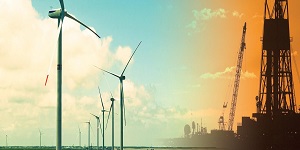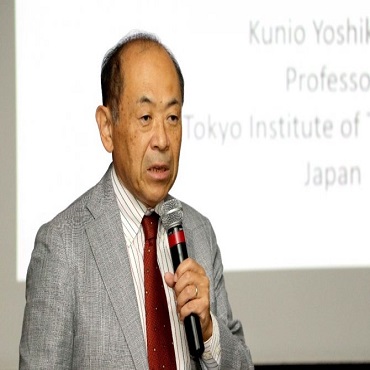
Energy 2019

Theme: Research at the Interface of Energy and Sustainability
Energy 2019 Conference gathers all the global leaders in Energy department to share their research at this exclusive scientific program, The conference throws light on thought-provoking topics and recent research in the field of Renewable Energy, Green Energy and Economy, Advanced Materials for Energy Storage, Generation and Transmission, Hybrid Renewable Energy Approaches, Biofuels and Bio-energy, Sustainable Nuclear Energy, Solar and Wind Energy, Hydro Power Generation, Marine -Tidal and Wave Energy, Smart Grid Systems, and many more.
The organizing committee is gearing up for an exciting and informative conference program including plenary lectures, symposia, workshops on a variety of topics, poster presentations and various programs for participants from all over the world. We invite you to join Energy 2019 Conference, where you are sure to have a meaningful experience with scholars from around the world.
Renewable Energy Conference | Green Energy Conference | Sustainable Energy Conference | Non-Renewable Energy conference | Energy Conference | Biofuel Conference | Waste-To-Energy Conference | Solar Energy Conferences | Energy Meetings | Power and Energy Conferences | Bioenergy Conferences | Marine Energy Conferences | Renewable and Non Renewable Energy Conferences
Scientific Session
Track 1: Trends in Renewable Energy
The Global Trends in Renewable Energy Investment 2018 report, published by UN Environment. Last year was the eighth in a row in which global investment in renewables exceeded $200 billion – and since 2004, the world has invested $2.9 trillion in these green energy sources. Overall, China was by far the world’s largest investing country in renewables, at a record $126.6 billion, up 31 per cent on 2016. Solar energy dominated global investment in new power generation like never before in 2017. The world installed a record 98 giga watts of new solar capacity, far more than the net additions of any other technology – renewable, fossil fuel or nuclear and solar power attracted far more investment, at $160.8 billion, up 18 per cent, than any other technology.
Related Conferences:
Global Congress on Renewable & Non Renewable Energy, April 16-17, 2019, Rome Italy | 21st International Conference on Renewable Energy Resources and Applications, June 25 - 26, 2019, Paris, France | 5th International Conference on Environment and Renewable Energy, Feb 25-27, 2019, Ho Chi Minh City, Vietnam | International Conference on Sustainability, Energy & the Environment (IICSEEHAWAII), January 03 - 05 2019, Honolulu, USA
Track 2: Green Energy and Economy
Eco-friendly sources of energy, also known as Green energy or renewable energy sources, have acquired tremendous attention and acceptance in the past few years as governments, organizations and people all over the world are embracing their environmental responsibilities. Renewable energy sources include solar, wind, water, snow, and rain. In addition to not having an adverse impact on the environment, these energy sources will never die out as they are continuously replenished. Monopoly-based organizational structures defined the energy market during its early history. Due to extraordinary circumstances in the 1970s, the market saw a radical overhaul that led to liberalization in some countries. Today, we are at the cusp of what may be another radical overhaul in the market.
Related Conferences:
Wind Energy Symposium, Jan 07 - 11 2019, San Diego, USA | Handelsblatt Conference Renewables Energy, January 22 - 24 2019, Berlin, Germany | International Conference on Smart Grid and Green Energy (SGGE), January 23 – 25, 2019, Singapore | International Conference on Renewable Energy Technologies (ICRET), January 26 – 28, 2019, Seoul, South Korea
Track 3: Advanced Materials for Energy Storage, Generation and Transmission
The increased deployment of renewable generation of energy, coupled with the high cost of managing peak grid demand, is driving interest in stationary energy storage technologies within the utilities industries. Grid reliability and the large capital costs of upgrading the nation's electrical transmission systems are sparking interest in distributed energy generation and storage. And in the transportation sector, the volatility of fuel prices and the desire to create a competitive domestic battery manufacturing industry have all led to rapid growth in research in advanced energy storage technologies.
Related Conferences:
Annual International Conference on Sustainable Energy and Environmental Sciences (SEES), January 28 – 29, 2019, Singapore | Renewable Energy Law, January 28 - 29 2019, Austin, USA | Energy Conference, May 13 – 14 2019, Austin, USA | World Waste to Energy City Summits, May 21 – 22, 2019, London, UK | Global Energy Conference, June 05 – 06, 2019, Houston, USA | Renewable Energy Asia, June 05 – 08, 2019, Bangkok, Thailand | World Congress and Expo on Green Energy, June 24 – 25, 2019, Granollers, Spain
Track 4: Hybrid Renewable Energy Approaches
Hybrid energy systems (HESs) are expanding due to environmental concerns of climate change, air pollution, and depleting fossil fuels. Moreover, HESs can be cost effective in comparison with conventional power plants. The current trend of research and development are focused in hybrid renewable energy systems (HRES) that allowing hybridization and optimization of the electrical generation.
- Biomass-wind-fuel cell
- Photovoltaic and wind
- Completely Renewable Idea
Related Conferences:
Global Congress on Renewable & Non Renewable Energy, April 16-17, 2019, Rome Italy | 21st International Conference on Renewable Energy Resources and Applications, June 25 - 26, 2019, Paris, France | 5th International Conference on Environment and Renewable Energy, Feb 25-27, 2019, Ho Chi Minh City, Vietnam | International Conference on Sustainability, Energy & the Environment (IICSEEHAWAII), January 03 - 05 2019, Honolulu, USA
Track 5: Biofuels and Bioenergy
Biomass can be used to produce renewable electricity, thermal energy, or transportation fuels. Bioenergy is often considered to be environmentally friendly because, in theory, the CO2 released when plants and trees are burned is balanced out by the CO2 absorbed by the new ones planted to replace those harvested. There are two main criticisms of biofuels. The first is that growing plants for energy puts pressure on land use, boosting deforestation and driving up food prices. The second is that the production of some biofuels has been linked to high levels of carbon emissions.
Related Conferences:
Wind Energy Symposium, Jan 07 - 11 2019, San Diego, USA | Handelsblatt Conference Renewables Energy, January 22 - 24 2019, Berlin, Germany | International Conference on Smart Grid and Green Energy (SGGE), January 23 – 25, 2019, Singapore | International Conference on Renewable Energy Technologies (ICRET), January 26 – 28, 2019, Seoul, South Korea
Track 6: Sustainable Nuclear Energy
Nuclear power is presently a sustainable energy source, but could become completely renewable if the source of uranium changed from mined ore to seawater. Since U extracted is continuously replenished through geologic processes, nuclear would become as endless as solar. “Not everything renewable is sustainable, and in turn not everything which is sustainable is necessarily renewable.”
Related Conferences:
Global Congress on Renewable & Non Renewable Energy, April 16-17, 2019, Rome Italy | 21st International Conference on Renewable Energy Resources and Applications, June 25 - 26, 2019, Paris, France | 5th International Conference on Environment and Renewable Energy, Feb 25-27, 2019, Ho Chi Minh City, Vietnam | International Conference on Sustainability, Energy & the Environment (IICSEEHAWAII), January 03 - 05 2019, Honolulu, USA
Track 7: Solar and Wind Energy
The earth intercepts lots of solar power, 173 trillion terawatts to be specific. That’s literally ten thousand more power than the entire world population utilizes. This validates the fact that the sun is the most plentiful source of energy on the entire globe and that it could one day be the most reliant source of energy. Combination solar wind power is an alternative approach to producing clean, non-polluting energy from two of the most abundant renewable energy sources. This system uses a hybrid solar panel and wind turbine generator to create electricity which is then stored in batteries.
Related Conferences:
Wind Energy Symposium, Jan 07 - 11 2019, San Diego, USA | Handelsblatt Conference Renewables Energy, January 22 - 24 2019, Berlin, Germany | International Conference on Smart Grid and Green Energy (SGGE), January 23 – 25, 2019, Singapore | International Conference on Renewable Energy Technologies (ICRET), January 26 – 28, 2019, Seoul, South Korea
Track 8: Marine Energy
Marine energy – also referred to as ocean energy, ocean power and marine hydrokinetic energy (MHK) – encompasses various means through which energy can be harnessed from our oceans. There are various types of marine energy, including wave, tidal stream, tidal range and offshore wind, as well as ocean thermal, ocean current, run-of-river and salinity.
Related Conferences:
Global Congress on Renewable & Non Renewable Energy, April 16-17, 2019, Rome Italy | 21st International Conference on Renewable Energy Resources and Applications, June 25 - 26, 2019, Paris, France | 5th International Conference on Environment and Renewable Energy, Feb 25-27, 2019, Ho Chi Minh City, Vietnam | International Conference on Sustainability, Energy & the Environment (IICSEEHAWAII), January 03 - 05 2019, Honolulu, USA
Track 9: Hydro Power Generation
Hydro energy is available in many forms, potential energy from high heads of water retained in dams, kinetic energy from current flow in rivers and tidal barrages, and kinetic energy also from the movement of waves on relatively static water masses. Hydro-electric power, using the potential energy of rivers, now supplies 17.5% of the world's electricity (99% in Norway, 57% in Canada, 55% in Switzerland, 40% in Sweden, 7% in USA). Hydropower is one of the biggest renewable sources of energy. As of 2010, it supplied about 3.3 per cent of the world’s energy consumption and was estimated to be worth $62 billion. The sector is projected to touch $74 billion in 2015. Hydroelectric power generation is by far the most efficient method of large scale electric power generation.
Related Conferences:
Annual International Conference on Sustainable Energy and Environmental Sciences (SEES), January 28 – 29, 2019, Singapore | Renewable Energy Law, January 28 - 29 2019, Austin, USA | Energy Conference, May 13 – 14 2019, Austin, USA | World Waste to Energy City Summits, May 21 – 22, 2019, London, UK | Global Energy Conference, June 05 – 06, 2019, Houston, USA | Renewable Energy Asia, June 05 – 08, 2019, Bangkok, Thailand | World Congress and Expo on Green Energy, June 24 – 25, 2019, Granollers, Spain
Track 10: Geothermal Energy
Geothermal energy is the heat from the Earth. Geothermal fields produce only about one-sixth of the carbon dioxide that a relatively clean natural-gas-fueled power plant produces. Binary plants release essentially no emissions. Unlike solar and wind energy, geothermal energy is always available, 365 days a year. The main concern is the release of hydrogen sulfide, a gas that smells like rotten egg at low concentrations. Another concern is the disposal of some geothermal fluids, which may contain low levels of toxic materials.
Related Conferences:
Wind Energy Symposium, Jan 07 - 11 2019, San Diego, USA | Handelsblatt Conference Renewables Energy, January 22 - 24 2019, Berlin, Germany | International Conference on Smart Grid and Green Energy (SGGE), January 23 – 25, 2019, Singapore | International Conference on Renewable Energy Technologies (ICRET), January 26 – 28, 2019, Seoul, South Korea
Track 11: Smart Grid Systems
A smart grid technology is an essential to provide easy integration and reliable service to the consumers. A smart grid system is a self-sufficient electricity network system based on digital automation technology for monitoring, control, and analysis within the supply chain. This system can find the solution to the problems very quickly in an existed system that can reduce the workforce and it will targets sustainable, reliable, safe and quality electricity to all consumers. The smart grid can be defined as a smart electrical network that combines electrical network and smart digital communication technology.
Related Conferences:
Global Congress on Renewable & Non Renewable Energy, April 16-17, 2019, Rome Italy | 21st International Conference on Renewable Energy Resources and Applications, June 25 - 26, 2019, Paris, France | 5th International Conference on Environment and Renewable Energy, Feb 25-27, 2019, Ho Chi Minh City, Vietnam | International Conference on Sustainability, Energy & the Environment (IICSEEHAWAII), January 03 - 05 2019, Honolulu, USA
Track 12: Waste to Energy
Waste to Energy (WTE), is a term that is used to describe various technologies that convert non-recyclable waste into usable forms of energy including heat, fuels and electricity. WTE can occur through a number of processes such as incineration, gasification, pyrolysis, anaerobic digestion, and landfill gas recovery. Currently, the world generates 1.3 billion tonnes of Municipal Solid Waste (MSW) annually. By 2025 the world could generate 2.2 billion tonnes of MSW per year. Such a prediction forces us to consider and develop alternatives for addressing our future waste management (WM) challenges.
Related Conferences:
Wind Energy Symposium, Jan 07 - 11 2019, San Diego, USA | Handelsblatt Conference Renewables Energy, January 22 - 24 2019, Berlin, Germany | International Conference on Smart Grid and Green Energy (SGGE), January 23 – 25, 2019, Singapore | International Conference on Renewable Energy Technologies (ICRET), January 26 – 28, 2019, Seoul, South Korea
Track 13: Global Impacts of Using Non-Renewable Resources
Non-renewable energies are those that do not self-sustain naturally. Examples of non-renewable energies are coal, oil and natural gas. Unlike renewable energy sources like wind, water and sun--most of which are converted to power cleanly--the conversion of fossil fuels to usable energy can result in harmful emissions and its collection can disrupt local wildlife. A 2004 study concluded that pollution from coal-powered plants shortened nearly 24,000 lives a year in the U.S.
Related Conferences:
Annual International Conference on Sustainable Energy and Environmental Sciences (SEES), January 28 – 29, 2019, Singapore | Renewable Energy Law, January 28 - 29 2019, Austin, USA | Energy Conference, May 13 – 14 2019, Austin, USA | World Waste to Energy City Summits, May 21 – 22, 2019, London, UK | Global Energy Conference, June 05 – 06, 2019, Houston, USA | Renewable Energy Asia, June 05 – 08, 2019, Bangkok, Thailand | World Congress and Expo on Green Energy, June 24 – 25, 2019, Granollers, Spain
Track 14: Fossil and Radioactive Fuels
Fossil fuels dominate the power sector and will continue to do so in the foreseeable future. Strong growth in non-OECD (Organization for Economic Co-operation and Development) countries exceeds the reductions in OECD countries, thereby extending a lifeline of fossil fuels. However, their share of the energy generation market is expected to decline from 68 per cent in 2011 to 57 per cent in 2035.
Related Conferences:
Global Congress on Renewable & Non Renewable Energy, April 16-17, 2019, Rome Italy | 21st International Conference on Renewable Energy Resources and Applications, June 25 - 26, 2019, Paris, France | 5th International Conference on Environment and Renewable Energy, Feb 25-27, 2019, Ho Chi Minh City, Vietnam | International Conference on Sustainability, Energy & the Environment (IICSEEHAWAII), January 03 - 05 2019, Honolulu, USA
Market Research
Scope and Importance:
Global Renewable Energy generation has increased by 6.7% between 2015 and 2016, but global CO2 emissions are also on the rise. Energy 2019 focuses on bringing together renewable and non-renewable energy experts, policy makers, economists, academicians and students to discuss the current state of research and development in energy strategies. It emphasizes talks on Economics of Renewable Energy and Non-Renewable Energy, Smart Grid Systems, Advanced Energy Storage Materials, Nuclear Energy, Hybrid Renewable Energy Approaches, etc. to arrive at possible solutions in the near future for better development in this sector.
Major Energy Associations around the Globe:
- The American Wind Energy Association (AWEA), USA
- The Wind Energy Foundation, USA
- Women of Wind Energy, USA
- The Solar Energy Industries Association, US
- The Solar Foundation, US
- Agency for Non-conventional Energy and Rural Technology (ANERT), India
- American Council on Renewable Energy
- American Solar Energy Society
- Danish Organization for Renewable Energy
- European Renewable Energy Council
- Green Power Forum
- Office of Energy Efficiency and Renewable Energy
- Renewable Fuels Association
- Trends in Renewable Energy
- Green Energy and Economy
- Advanced Materials for Energy Storage, Generation and Transmission
- Hybrid Renewable Energy Approaches
- Biofuels, Bioenergy and Sustainable Nuclear Energy
- Solar, Wind and Marine Energy
- Hydro Power Generation and Geothermal Energy
- Waste to Energy and Smart Grid Systems
- Global Impacts of Using Non-Renewable Resources
- Fossil and Radioactive Fuels
- Petroleum Engineering and Natural Gas Recovery
- Journal of Nuclear Energy Science & Power Generation Technology
- Journal of Hydrogeology & Hydrologic Engineering
7 Organizing Committee Members
10 Renowned Speakers
Govinda Timilsina
Development Research Group,
The World Bank
USA
Abhishek Asthana
Sheffield Hallam University
UK
Adango Miadonye
Chemical Engineering and Industrial Chemistry in the School of Science & Technology
Canada
Mahmoud Bady
The Islamic University of Madinah, KSA
Saudi Arabia
Guo Zhi
PetroChina Research Institute of Petroleum Exploration & Development
China
Ailin Jia
Petrochina Research Institute of Petroleum Exploration and Development
China
Daniel Lehser-Pfeffermann
University of applied Sciences Saarbrucken
Germany
Joao Santos
University of Birmingham
UK
Daniel Adu
Jiangsu University
China
Abdullatif Hakami
University of South Florida
USA



































































































































